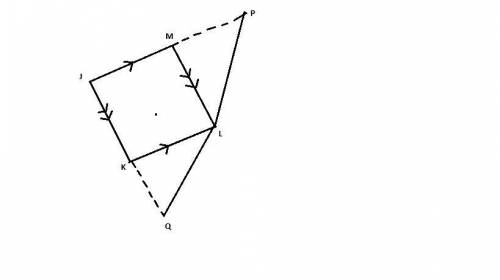
Mathematics, 15.07.2019 13:20 BIGJAYWESTSIDE
The following is an incomplete flowchart proving that the opposite angles of parallelogram jklm are congruent: parallelogram jklm is shown where segment jm is parallel to segment kl and segment jk is parallel to segment ml. extend segment jm beyond point m and draw point p, by construction. an arrow is drawn from this statement to angle mlk is congruent to angle pml, alternate interior angles theorem. an arrow is drawn from this statement to angle pml is congruent to angle kjm, numbered blank 1. an arrow is drawn from this statement to angle mlk is congruent to angle kjm, transitive property of equality. extend segment jk beyond point j and draw point q. an arrow is drawn from this statement to angle jml is congruent to angle qjm, alternate interior angles theorem. an arrow is drawn from this statement to angle qjm is congruent to angle lkj, numbered blank 2. an arrow is drawn from this statement to angle jml is congruent to angle lkj, transitive property of equality. two arrows are drawn from this previous statement and the statement angle mlk is congruent to angle kjm, transitive property of equality to opposite angles of parallelogram jklm are congruent. which reasons can be used to fill in the numbered blank spaces? 1alternate interior angles theorem 2alternate interior angles theorem1corresponding angles theorem 2corresponding angles theorem 1same-side interior angles theorem 2alternate interior angles theorem1same-side interior angles theorem 2corresponding angles theorem

Answers: 2


Another question on Mathematics

Mathematics, 21.06.2019 17:00
Asays "we are both knaves" and b says nothing. exercises 24–31 relate to inhabitants of an island on which there are three kinds of people: knights who always tell the truth, knaves who always lie, and spies (called normals by smullyan [sm78]) who can either lie or tell the truth. you encounter three people, a, b, and c. you know one of these people is a knight, one is a knave, and one is a spy. each of the three people knows the type of person each of other two is. for each of these situations, if possible, determine whether there is a unique solution and determine who the knave, knight, and spy are. when there is no unique solution, list all possible solutions or state that there are no solutions. 24. a says "c is the knave," b says, "a is the knight," and c says "i am the spy."
Answers: 2

Mathematics, 21.06.2019 18:40
That table shows measurements (in invhes$ from cubes with different side lengths. which pairs of variables have a linear relationship? check all that apply
Answers: 3


You know the right answer?
The following is an incomplete flowchart proving that the opposite angles of parallelogram jklm are...
Questions


Business, 02.08.2019 17:30

Mathematics, 02.08.2019 17:30

Computers and Technology, 02.08.2019 17:30


Chemistry, 02.08.2019 17:30







Geography, 02.08.2019 17:30




Mathematics, 02.08.2019 17:30

Chemistry, 02.08.2019 17:30

History, 02.08.2019 17:30

History, 02.08.2019 17:30




